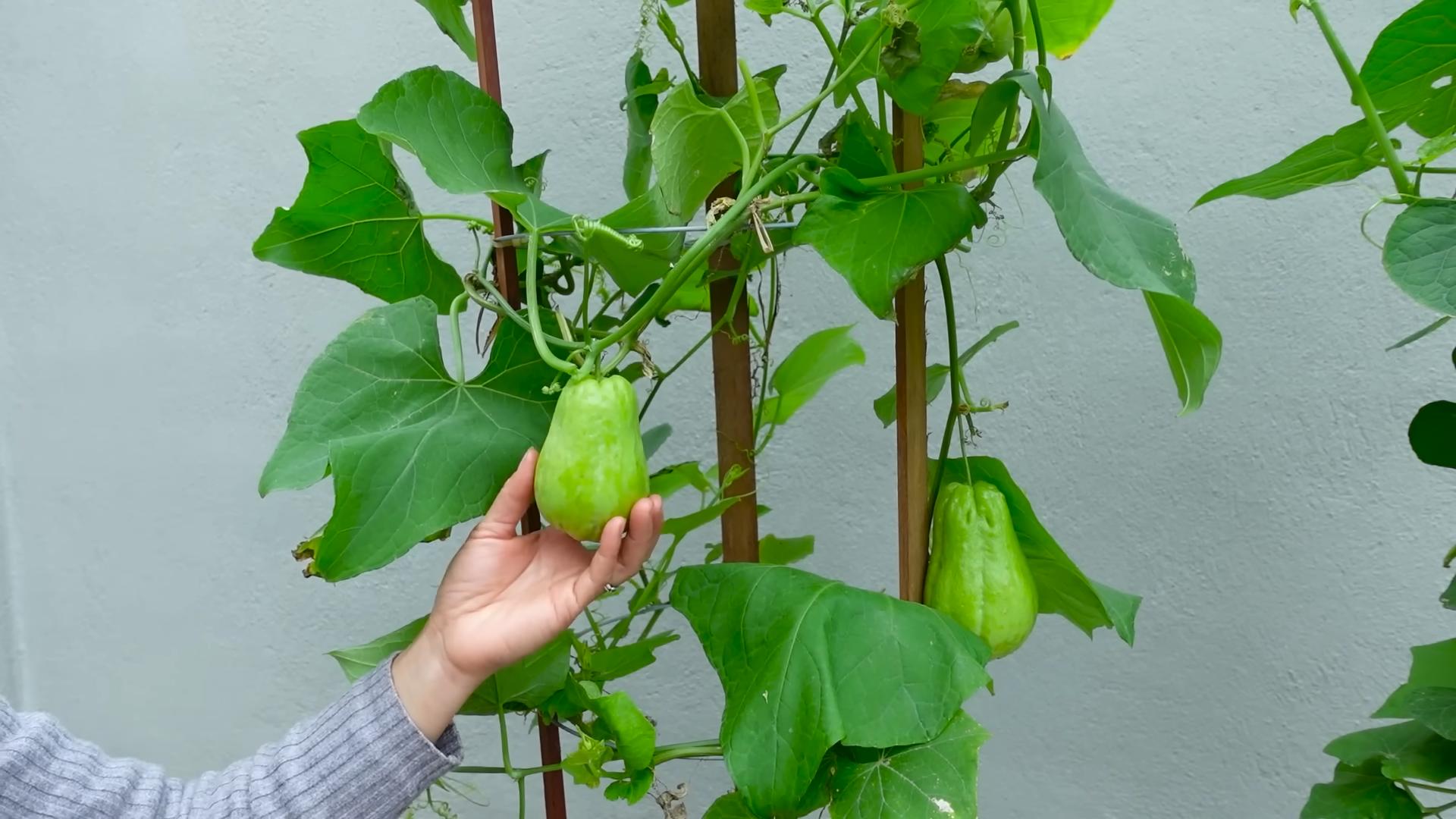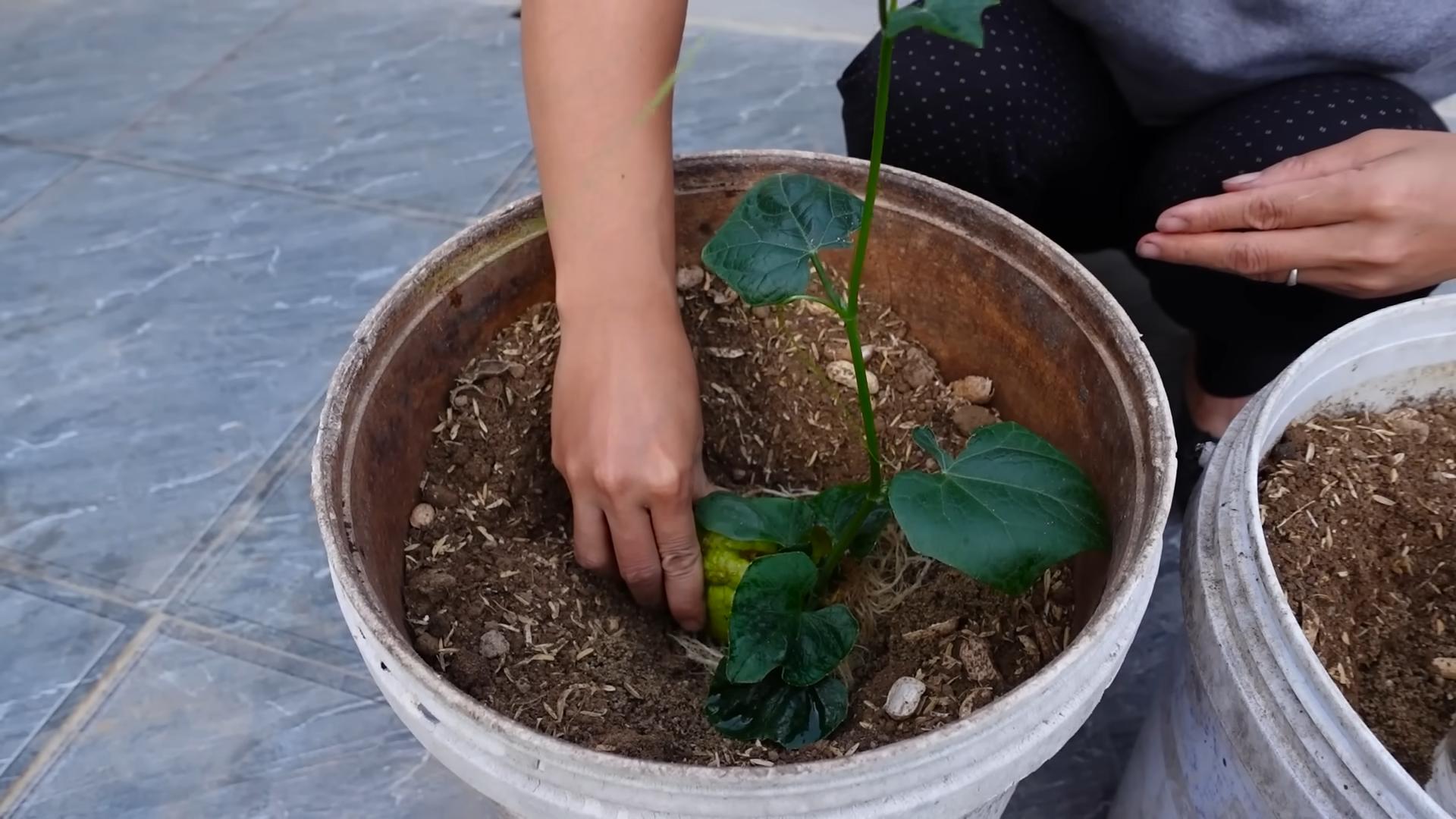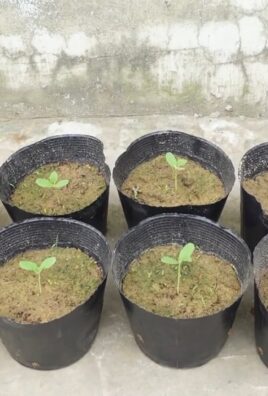Growing Chayote in a Bucket might sound like a quirky experiment, but trust me, it’s a game-changer for anyone with limited garden space or a yearning for fresh, homegrown produce! Have you ever dreamt of harvesting your own vibrant, pear-shaped chayote squash, but felt constrained by a tiny balcony or patio? Well, dream no more! This DIY guide will unlock the secrets to successfully cultivating this versatile vegetable, right in the comfort of a humble bucket.
Chayote, also known as mirliton or vegetable pear, boasts a rich history, deeply rooted in Mesoamerican cultures. For centuries, it has been a staple ingredient, prized for its mild flavor and incredible versatility. From savory stews to refreshing salads, chayote adds a delightful touch to countless dishes. But beyond its culinary appeal, this remarkable squash is also incredibly easy to grow, making it a perfect choice for beginner gardeners.
Why should you embrace this DIY trick? Because growing chayote in a bucket offers a practical solution for urban dwellers and space-conscious gardeners. It allows you to enjoy the satisfaction of harvesting your own fresh produce, even without a traditional garden. Plus, it’s a fantastic way to reduce your carbon footprint and embrace a more sustainable lifestyle. So, grab your bucket, some soil, and a chayote fruit, and let’s embark on this exciting gardening adventure together! I’m excited to show you how simple and rewarding it can be.

Growing Chayote Squash in a Bucket: A Complete DIY Guide
Hey there, fellow gardening enthusiasts! Ever thought about growing your own chayote squash? It’s a fantastic, versatile vegetable, and you don’t even need a huge garden to do it. I’m going to walk you through how to grow chayote right in a bucket! It’s easier than you might think, and the reward of fresh, homegrown chayote is totally worth it.
What You’ll Need
Before we dive in, let’s gather our supplies. Here’s a list of everything you’ll need to successfully grow chayote in a bucket:
* A Large Bucket: Aim for at least a 10-gallon bucket. The bigger, the better, as chayote vines are vigorous growers. Make sure it has drainage holes!
* Chayote Fruit: You’ll need a mature chayote fruit that has already started to sprout. You can usually find these at your local grocery store or farmer’s market. Look for one with a small sprout emerging from the bottom.
* Potting Mix: Use a high-quality potting mix that drains well. Avoid using garden soil, as it can become compacted in a container.
* Compost: Compost is your friend! It adds nutrients and improves soil structure.
* Trellis or Support: Chayote vines need something to climb on. A trellis, sturdy stakes, or even a fence will work.
* Watering Can or Hose: For regular watering.
* Gloves: To protect your hands.
* Optional: Slow-Release Fertilizer: To provide a steady supply of nutrients.
Preparing the Chayote Fruit
This is a crucial step. We need to encourage that sprout to grow into a healthy vine.
1. Inspect the Fruit: Carefully examine your chayote fruit. The sprout should be visible and healthy-looking. If it’s shriveled or damaged, try to find another fruit.
2. Sprouting (If Necessary): Sometimes, the chayote fruit hasn’t sprouted much when you get it. If that’s the case, you can encourage sprouting by placing the fruit in a warm, humid location. You can partially bury it in a container filled with moist vermiculite or perlite, leaving the top exposed. Keep it consistently moist, but not soggy. It usually takes a week or two for the sprout to really take off.
3. Gentle Handling: Be very gentle when handling the chayote fruit, especially the sprout. It’s delicate and can be easily damaged.
Planting the Chayote
Now for the fun part! Let’s get that chayote planted.
1. Prepare the Bucket: Make sure your bucket has adequate drainage holes. If not, drill a few in the bottom.
2. Fill the Bucket: Fill the bucket about two-thirds full with your potting mix. Mix in a generous amount of compost. I usually go for a ratio of about 2 parts potting mix to 1 part compost. If you’re using slow-release fertilizer, mix it in according to the package directions.
3. Position the Chayote: Create a small depression in the center of the potting mix. Carefully place the chayote fruit horizontally in the depression, with the sprout pointing upwards. The top of the fruit should be just barely covered with soil.
4. Cover and Water: Gently cover the fruit with the remaining potting mix, leaving the sprout exposed. Water thoroughly until the water drains out of the bottom of the bucket.
Setting Up the Trellis
Chayote vines are climbers, so they need a trellis or other support structure.
1. Choose Your Trellis: Select a trellis that is tall and sturdy enough to support a mature chayote vine. They can grow quite long! A trellis that’s at least 6-8 feet tall is a good starting point.
2. Position the Trellis: Place the trellis behind the bucket, making sure it’s securely anchored. You can use stakes to help stabilize it.
3. Guide the Vine: As the chayote vine grows, gently guide it onto the trellis. You may need to tie it to the trellis with soft twine or plant ties.
Caring for Your Chayote Plant
Consistent care is key to a successful chayote harvest.
1. Watering: Water your chayote plant regularly, especially during hot, dry weather. The soil should be consistently moist, but not waterlogged. Check the soil moisture by sticking your finger into the soil. If the top inch feels dry, it’s time to water.
2. Fertilizing: Chayote plants are heavy feeders. In addition to the compost you added at planting time, you can fertilize your plant every few weeks with a balanced liquid fertilizer. Follow the package directions for application rates.
3. Sunlight: Chayote plants need plenty of sunlight. Aim for at least 6-8 hours of direct sunlight per day.
4. Pruning: Pruning can help to keep your chayote vine manageable and encourage fruit production. You can prune back excessive growth and remove any dead or damaged leaves.
5. Pest and Disease Control: Keep an eye out for pests and diseases. Common pests that can affect chayote plants include aphids, spider mites, and squash bugs. You can control these pests with insecticidal soap or neem oil. Diseases are less common, but powdery mildew can sometimes be a problem. Improve air circulation and avoid overhead watering to help prevent powdery mildew.
Pollination
Chayote plants produce both male and female flowers. The female flowers need to be pollinated in order to produce fruit.
1. Natural Pollination: In most cases, chayote plants are pollinated by insects, such as bees and butterflies. To encourage pollination, you can plant flowers that attract pollinators near your chayote plant.
2. Hand Pollination (If Necessary): If you’re not seeing much insect activity, you can hand-pollinate your chayote flowers. To do this, use a small paintbrush to transfer pollen from the male flowers to the female flowers. The male flowers are the ones with the long, slender stems. The female flowers have a small, immature fruit at the base.
Harvesting Your Chayote
The moment we’ve all been waiting for!
1. Harvest Time: Chayote fruits are typically ready to harvest about 4-6 weeks after the flowers are pollinated. The fruits should be firm and green.
2. Harvesting Technique: Use a sharp knife or pruners to cut the fruit from the vine. Leave a small stem attached to the fruit.
3. Storage: Chayote fruits can be stored in the refrigerator for several weeks.
Troubleshooting
Even with the best care, you might encounter some challenges. Here are a few common problems and how to address them:
* No Fruit Production: This could be due to a lack of pollination, insufficient sunlight, or inadequate fertilization. Make sure your plant is getting enough sunlight and fertilizer, and try hand-pollinating the flowers.
* Yellowing Leaves: Yellowing leaves can be a sign of overwatering, underwatering, or nutrient deficiency. Check the soil moisture and adjust your watering accordingly. Fertilize your plant with a balanced fertilizer.
* Pest Infestation: Treat pest infestations promptly with insecticidal soap or neem oil.
Enjoying Your Harvest
Chayote squash is incredibly versatile in the kitchen. You can use it in soups, stews, stir-fries, salads, and even desserts! It has a mild flavor that takes on the flavors of the other ingredients in your dish. I personally love it in a simple stir-fry with garlic, ginger, and soy sauce.
Growing chayote in a bucket is a rewarding experience. With a little care and attention, you can enjoy a bountiful harvest of fresh, homegrown chayote squash. Happy gardening!

Conclusion
So, there you have it! Growing chayote in a bucket is not just a possibility; it’s a surprisingly rewarding and accessible project for gardeners of all levels. We’ve walked you through the steps, from selecting the right bucket and preparing the soil to nurturing your plant and anticipating that first delicious harvest.
Why is this DIY trick a must-try? Because it democratizes chayote cultivation. No sprawling garden? No problem! Limited space? Chayote in a bucket is your answer. It’s also a fantastic way to control the growing environment, protect your plant from harsh weather, and even move it to optimize sunlight exposure. Plus, there’s a unique satisfaction in nurturing a plant from a single fruit to a thriving vine laden with produce, all within the confines of a humble bucket.
But the adventure doesn’t stop there! Feel free to experiment with variations. Try different soil mixes to see what works best in your climate. Consider adding companion plants like marigolds or basil to deter pests naturally. Explore different trellising methods to support the vigorous growth of your chayote vine. You could even try growing different varieties of chayote, each with its own unique flavor and texture.
Remember, growing chayote in a bucket is a journey of discovery. Don’t be afraid to make mistakes, learn from them, and adapt your approach as needed. The most important thing is to have fun and enjoy the process.
We are confident that with a little patience and care, you’ll be harvesting your own fresh, homegrown chayote in no time. Imagine the delicious meals you can create – from stir-fries and soups to salads and even desserts! The possibilities are endless.
Now, it’s your turn! We wholeheartedly encourage you to give this DIY trick a try. Embrace the challenge, get your hands dirty, and experience the joy of growing your own food. And most importantly, share your experience with us! We’d love to hear about your successes, your challenges, and any tips or tricks you discover along the way. Post photos of your chayote plants, share your favorite recipes, and let’s build a community of bucket-chayote enthusiasts!
Growing your own food, especially something as unique and versatile as chayote, is an incredibly empowering experience. It connects you to nature, promotes sustainable living, and provides you with fresh, healthy produce that you can be proud of. So, grab a bucket, get some soil, and let’s start growing! We can’t wait to see what you create. Happy gardening!
Frequently Asked Questions (FAQ)
What is the best size bucket for growing chayote?
A minimum of 10-gallon bucket is recommended, but a 20-gallon bucket or larger is ideal. Chayote vines are vigorous growers and need ample space for their root systems to develop. A larger bucket will also provide better water retention and stability for the plant. If you live in a very hot climate, a larger, darker-colored bucket might heat up too much, so consider a lighter color or wrapping the bucket in reflective material.
What kind of soil should I use for growing chayote in a bucket?
A well-draining potting mix is crucial. Avoid using garden soil, as it can become compacted in a container and hinder drainage. A good mix would include equal parts of compost, peat moss (or coconut coir), and perlite or vermiculite. The compost provides nutrients, the peat moss/coir helps retain moisture, and the perlite/vermiculite improves drainage and aeration. You can also add a slow-release fertilizer to the mix to provide a steady supply of nutrients throughout the growing season.
How often should I water my chayote plant in a bucket?
Water deeply and regularly, especially during hot and dry weather. Check the soil moisture regularly by sticking your finger about an inch into the soil. If it feels dry, it’s time to water. Avoid overwatering, as this can lead to root rot. Ensure the bucket has adequate drainage holes to prevent water from pooling at the bottom. The frequency of watering will depend on factors such as the weather, the size of the bucket, and the maturity of the plant.
How much sunlight does a chayote plant need?
Chayote plants need at least 6-8 hours of direct sunlight per day to thrive. Choose a location that receives plenty of sunlight throughout the day. If you live in a very hot climate, some afternoon shade may be beneficial to prevent the plant from getting scorched. If you don’t have a sunny spot, you can supplement with grow lights.
How do I trellis a chayote vine grown in a bucket?
Chayote vines are vigorous climbers and need a sturdy trellis to support their growth. You can use a variety of trellising methods, such as a bamboo teepee, a wire mesh fence, or a wooden trellis. The trellis should be tall and strong enough to support the weight of the vine and the fruits. Secure the trellis firmly to the bucket or the ground to prevent it from tipping over. You can also train the vine to climb a nearby fence or wall.
When will my chayote plant start producing fruit?
Chayote plants typically start producing fruit in the fall, after the days begin to shorten. It can take several months for the plant to mature and start flowering. Be patient and continue to provide proper care, and you will eventually be rewarded with a bountiful harvest. The exact timing will depend on your climate and the variety of chayote you are growing.
How do I know when a chayote fruit is ripe?
Chayote fruits are typically harvested when they are still young and tender, about 4-6 inches in length. The skin should be smooth and light green. Avoid harvesting fruits that are too large or have a tough skin. You can also gently press the fruit; it should feel firm but not hard.
Can I grow chayote from a store-bought fruit?
Yes, you can grow chayote from a store-bought fruit, but it’s important to choose a healthy, mature fruit. Look for a fruit that is free from blemishes and has a small sprout emerging from the bottom. Place the fruit in a warm, humid location until the sprout develops further, then plant it in a bucket as described above. Keep in mind that store-bought fruits may not always be the best quality, so your success rate may vary.
Are there any pests or diseases that affect chayote plants?
Chayote plants are generally resistant to pests and diseases, but they can be susceptible to aphids, spider mites, and squash bugs. Inspect your plants regularly for signs of infestation and take appropriate action if necessary. You can use insecticidal soap or neem oil to control pests. Good air circulation and proper watering can help prevent fungal diseases.
Can I overwinter my chayote plant in a bucket?
In colder climates, chayote plants are typically grown as annuals, as they are not frost-tolerant. However, you can try to overwinter your plant by bringing the bucket indoors before the first frost. Cut back the vine to about 12 inches and place the bucket in a cool, dark location. Water sparingly throughout the winter. In the spring, gradually acclimate the plant to outdoor conditions and resume regular watering and fertilizing. Keep in mind that overwintering is not always successful, but it’s worth a try if you want to extend the life of your plant.
What are some good companion plants for chayote?
Good companion plants for chayote include marigolds, basil, nasturtiums, and other herbs that deter pests. Planting these alongside your chayote can help protect it from insects and diseases. Avoid planting chayote near members of the cucurbit family (such as cucumbers, squash, and melons), as they can compete for resources and attract similar pests.
Is it possible to grow chayote indoors year-round?
While challenging, growing chayote indoors year-round is possible with the right conditions. You’ll need a very large container, a strong trellis, and powerful grow lights to provide adequate sunlight. Maintaining consistent temperature and humidity levels is also crucial. Pollinating the flowers by hand may be necessary, as there will be no natural pollinators indoors. Be prepared for a significant commitment of time and resources if you choose to grow chayote indoors.





Leave a Comment